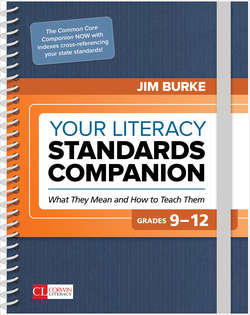Читать книгу Your Literacy Standards Companion, Grades 9-12 - Jim Burke - Страница 37
На сайте Литреса книга снята с продажи.
Common Core Reading Standard 1: What the Teacher Does
ОглавлениеTo teach students how to “read closely,” do the following:
Provide students access to the text—via tablet or photocopy—so they can annotate it as directed.
Model close reading for students by thinking aloud as you go through the text with them or displaying your annotations on a tablet via an LCD projector; show them how to examine a text by scrutinizing its words, sentence structures, or any other details needed to understand its explicit meaning.
Display the text via tablet or computer as you direct students’ attention—by highlighting, circling, or otherwise drawing their attention—to specific words, sentences, or paragraphs that are essential to the meaning of the text; as you do this, ask them to explain what a word means or how it is used in that sentence or how a specific sentence contributes to the meaning of the larger text.
Pose questions—about words, actions, details—that require students to look closely at the text for answers.
To get students to determine “what the text says explicitly,” do the following:
Ask students to “say what it says”—not what it means, since the emphasis here is on its literal meaning.
Offer students an example of what it means to read explicitly and support your inferences with evidence; then tell them what a passage explicitly says, asking them to find evidence inside the text to support their statement about its meaning.
Give students several pieces of evidence and ask them to determine what explicit idea in the text the evidence supports.
To develop students’ ability to “cite specific textual evidence,” do the following:
Offer them a set of samples of evidence of different degrees of specificity and quality to evaluate, requiring them to choose the one that is best and provide a rationale for their choice.
Show students how you would choose evidence from the text to support your inference; discuss with them the questions you would ask to arrive at that selection.
To “make logical inferences,” ask students to do the following:
Add what they learned (from the text about this subject) compared to what they already know (about that subject); then, have students confirm that their reasoning is sound by finding evidence for their inferences.
Think aloud (with your guidance) about the process and how they make such inferences, and then have students find and use evidence to support their inferences.
To identify “uncertainties,” “gaps,” or “inconsistencies,” students can try the following:
Read—or reread—key sections that focus on reasoning or evidence, and ask, “So what?” or any of the reporter’s questions (who, what, when, where, why, how) that seem appropriate to the text or topic, looking for those spots that cannot answer these basic questions logically or fully.
To help your English Language Learners, try this strategy:
Repeat the process used to make such inferences, verbally labeling each step as you demonstrate it; then ask them to demonstrate their ability to do it on their own or with your prompting. Post the steps (e.g., “Inferences = What You Know + What You Learned”) with an example on a poster or handout they can reference on their own as needed.
